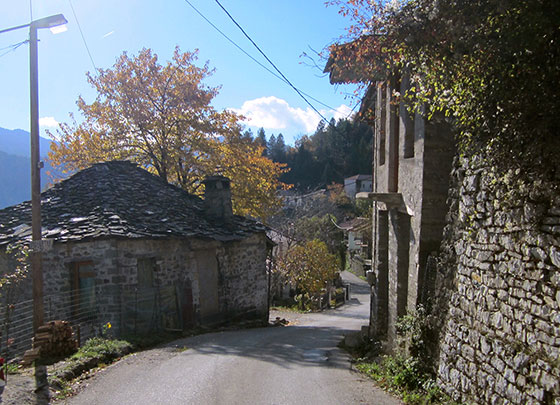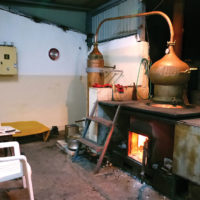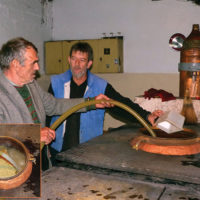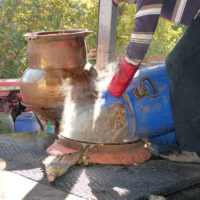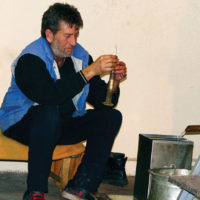Nectar of the gods
by Harold Wollin
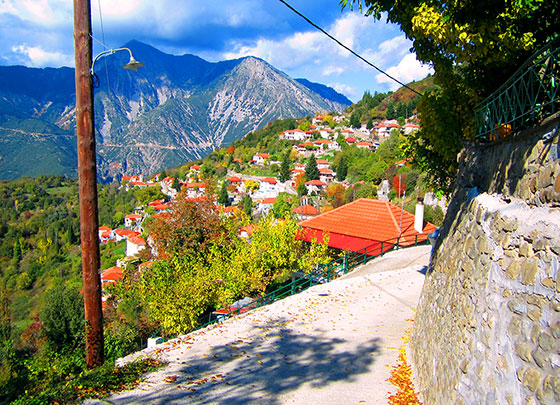
The clear liquid turns milky as it settles around the ice.
“Ouzo?” I ask as I take a sip.
“No,” Yanni waggles his finger at me. “Not ouzo. Tsipouro—from my grapes!” I’m in Greece on a backcountry road trip, hoping to learn about ouzo, the unique liquorice-flavoured spirit synonymous with Greek vacations.
Having just traversed the twisty roads on the far side of Mount Olympus, we’ve landed at the home of my travelling partner’s relatives.
The kitchen is a cacophony of laughter and banter. As Yanni refills our glasses, his wife fills the table with a continuous stream of traditional mezes; soft, rich feta smothered in olive oil, fried anchovies, dolmades, olives, peppers baked in feta, hummus, souflaki, fried potatoes and loaves of crisp fresh white bread.
“Eat! Eat!” she insists.
I heartily follow her instructions and sip the smooth, tasty elixir. This not-ouzo seems to pair well with everything. The first bottle disappears and a new bottle magically takes its place.
“From last year,” Yanni beams as he pulls the cork.
He describes how tsipouro’s roots go back to the Byzantine era, to the monks of Mount Athos, who would ferment and distil the pomace left over from the wine press. Each monastery had its own secret recipe of aromatic herbs. Eventually the anise-flavoured spirit won the hearts of the folk and became known as ouzo. Branding and commercialization has compromised purity, and now, to be called ouzo, it requires only 30 per cent grapes. The rest is some kind of ethanol, resulting in a guaranteed hangover with a liquorice aftertaste.
The folk developed a taste for the stuff, and now, 500 years later, they are still making their own. In fact, most farmers will turn their entire grape harvest into tsipouro. These days there is a still in nearly every village, each with its own secret recipe handed down for generations. Although grapes make the real tsipouro, any fruit will do. For instance, in Macedonia where Mastika originates, the preferred fruit is plums, and the herb is mastic, the resin from an indigenous evergreen.
November is late for the grape harvest, but it is prime time for tsipouro production. Yanni suggests a visit to their local still. He quickly makes a phone call and returns with a big smile, “He is cooking tomorrow!”
It’s late afternoon when we arrive. It smells of fermenting fruit and wood smoke inside the rustic building. My eyes adjust to the dim light of a lonely bare bulb. The floor is dirt and the still looks hand-made, the copper vessel glowing in the light from the open door of the oven. There’s a cot in the corner. The still master seems wary of me.
“He thinks you might be a Euro spy,” Yanni whispers, “The EU wants to license and cripple the local distilleries.”
But hearing that I am a Canadian tourist, he cracks a grin for my camera.
“Kalimera!” he says, beckoning me in.
A farmer enters and unloads large drums of fermented grapes and places wood near the stove, a measure that saves him the cost of propane. The first barrel of must (crushed fermented grapes, skin, juice, seeds and all) is dumped into the still and the fire is stoked. All eyes are on the spout. Soon it is pouring faster than the showerhead at my hotel! The master fills a glass and offers a taste.
The murky liquid is earthy and a bit fruity. He ponders the readings of a hydrometer, and then pulls the top off the cooker, arresting the distillation. A hatch is opened at the still’s base, releasing the bleached, steaming residue. The hatch is closed, another barrel of must is added and the process is repeated until the farmer’s drums have been emptied.
For the second phase, the liquid from the first distillation is poured back into the cooker. The still master adds a large scoop of anise seeds. Although many like their tsipouro straight like the Italian grappa, this particular farmer prefers the liquorice taste.
The spout drips at first, then pours a steady stream. A glass is halfway filled with crystal liquid. We watch as the master measures water into it. The volume almost doubles before the clear liquid begins to turn milky.
“That is glykanisos, the essential oil of anise,” Yanni tells me. “It turns cloudy at 38 per cent. What is coming out of the still right now must be around 80 per cent.” The farmer smiles.
I feel privileged to have been invited to this hidden gem, a somewhat illicit distillery. I text a photo home. “How many people die from this stuff every year?” one friend asks. I am here to learn about this stuff so I ask Yanni.
“You have to trust your source,” he answers. “We grow our own grapes, and my family has been getting our tsipouro made by this man’s family for generations. Unlike our economy, we aren’t dead yet!” he laughs. “We are happy to drive the extra 20 kilometres to have him make our tsipouro.”
Each village’s producer has his own personal style, striving to flavour and filter his product to a level of purity that nobody else can match. And each customer swears by the purity of his own tsipouro. As we part ways, the farmer generously offers me a bottle from this batch, and the still master fetches a bottle of his best to add to my loot.
Back at Yanni’s, his wife is busy in the kitchen.
“You must be hungry!” she says as she covers the table with food. I bring out one of my bottles, but Yanni again waggles his finger at me as he drops another bottle on the table, insisting that I take mine back to Canada.
This generosity is a symptom of Greek hospitality. And it is that generosity that fuels their fierce grip on local culture in the face of the homogenization attempts by the EU. I’m happy to have discovered the true nectar of the Gods, right at the base of Mount Olympus.
Yia Mas!
